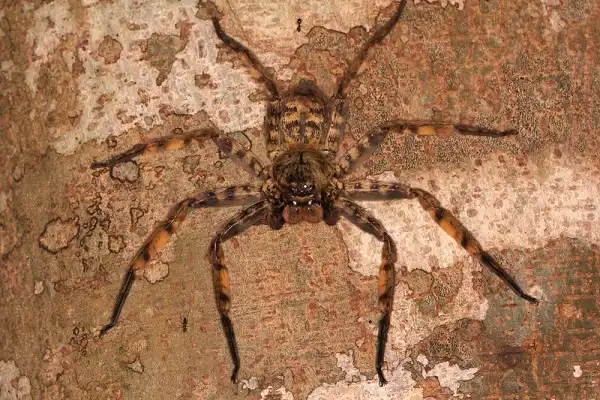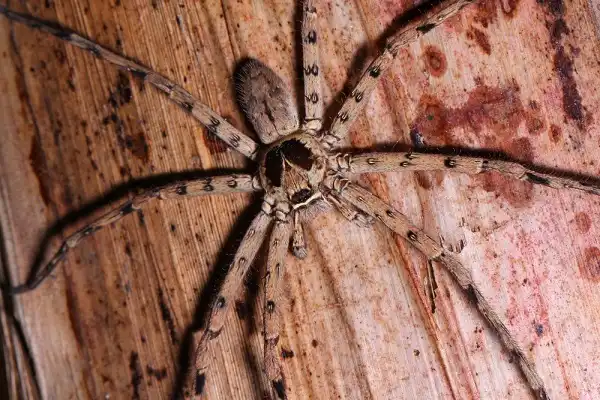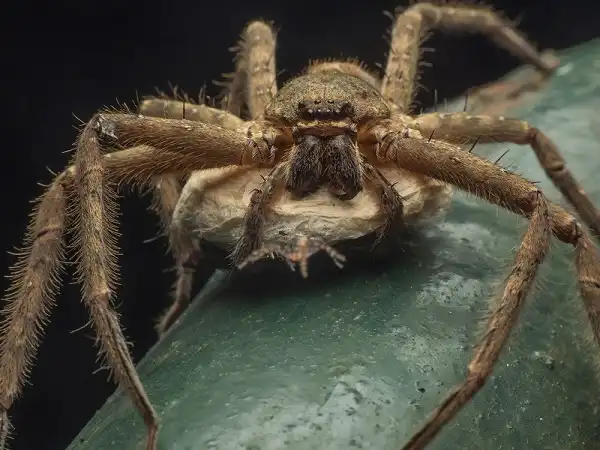Do you know how to identify a Huntsman Spider? This large, hairy arachnid is found in warm climates around the world and has many different species. They often travel into homes through cracks and crevices. But don’t worry too much if you find one inside your house; they rarely bite and are even beneficial since they feed on insects like cockroaches which can be a pesky household problem. In this blog post, we’ll explore basic facts about these curious creatures, their habits, and what to do if you encounter them indoors!

Huntsman Spider Description
Huntsman spiders are some of the largest spiders found in warm climates across the globe. They boast a striking appearance. Their long, hairy legs make them easily recognizable and give them a menacing aura. Huntsman spiders are exceptional hunters, using their speed and agility to catch prey both large and small. They are known for their adventurous nature and often venture indoors through cracks and crevices seeking prey. One interesting fact about Huntsman spiders is that they are able to flatten their bodies to fit into small spaces. This enables them to hide in tight spaces and ambush their prey. Additionally, Huntsman spiders are able to change their color to blend in with their environment, making them even harder to spot. One interesting fact about Huntsman spiders is that they have highly developed eyesight, which they use to navigate and locate prey. Their eyes have been specially adapted to detect motion and are capable of seeing in low-light conditions.
Huntsman Spider Habitat
Huntsman spiders are a truly remarkable species that have adapted to various habitats across the globe. They can be found in warm climates and are commonly seen in Australia, southern Asia, and Africa. Depending on their species, huntsman spiders prefer different habitats. Some prefer forested areas while others like to live near water sources. They are also found in houses, barns, and other human habitats. These spiders are hardy creatures that can adapt to different environments with ease. They are able to tolerate a range of temperature and humidity levels, making them highly adaptable. They are known to thrive in areas with lots of vegetation as it provides them with the perfect hiding places to ambush prey.
Huntsman Spider Diet
The Huntsman spider’s diet is diverse and includes a wide range of insects, making them a valuable natural predator in their ecosystem. Huntsman spiders are known for their impressive hunting skills and their ability to catch both large and small prey. They consume a variety of insects, including cockroaches, crickets, moths, and beetles, which are major household pests. Huntsman spiders are active hunters that rely on their speed and agility to catch their prey. Huntsman spiders do not build webs and rely solely on their hunting skills to catch prey. One interesting fact about Huntsman spiders is that they have a specialized feeding technique. They use their chelicerae, also known as fangs, to grasp and crush their prey before injecting them with venom to liquefy their insides. The Huntsman spider then uses its pedipalps to suck up the liquid prey, leaving behind only the empty exoskeleton.

Huntsman Spider Size
Huntsman spiders are a type of spider that belong to the family Sparassidae. They are known for their large size and impressive hunting abilities. In fact, Huntsman spiders are one of the biggest spiders in the world, with some species reaching a leg span of up to 12 inches. The size of Huntsman spiders varies depending on the species and the environment in which they live. While some species are larger than others, all Huntsman spiders have long, spindly legs that allow them to move quickly and gracefully. This is important when hunting because it allows them to chase down their prey and capture it with ease. Overall, the size of Huntsman spiders is just one of the many features that make them fascinating creatures.
Huntsman Spider Lifespan
Huntsman spiders are fascinating creatures that have many unique characteristics. In addition to their impressive hunting skills and large size, Huntsman spiders also have a relatively long lifespan compared to other spider species. The average lifespan of a Huntsman spider can vary depending on the species, but they typically live for around 1-2 years. Some species have been known to live for up to 3 years in the wild. This is a relatively long lifespan for a spider, as many species only live for a few months. One reason for the longer lifespan of Huntsman spiders is their ability to adapt to a wide range of environments. They are able to thrive in both tropical and temperate climates, as well as in both indoor and outdoor environments. This adaptability has allowed Huntsman spiders to survive and reproduce in many different habitats, helping to ensure the survival of the species. Huntsman spiders are remarkable creatures with many unique characteristics. Their ability to adapt to a range of environments, molt, and live for a relatively long time makes them a valuable part of many ecosystems. While they face many challenges in the wild, their impressive hunting skills and adaptable nature have helped them to survive and thrive for millions of years.
Huntsman Spider Behavior
Huntsman spiders are not only fascinating in their physical characteristics and lifespan but also in their behavior. These spiders are not aggressive towards humans, and will generally only bite if provoked or threatened. When threatened, Huntsman spiders will perform a defensive display by raising their front legs and displaying their large pedipalps. This display is meant to intimidate predators and deter them from attacking. Huntsman spiders are also known for their ability to coexist with humans. In addition to their interactions with humans, Huntsman spiders also have complex social structures among their own species. They have been observed engaging in cooperative hunting behaviors, with multiple spiders working together to catch prey. They also communicate with each other using a variety of signals, including vibrations, visual displays, and chemical signals.

Huntsman Spider Speed
Huntsman spiders are not only known for their remarkable hunting and social behavior but also for their impressive speed. Despite their relatively large size, these arachnids can move incredibly fast thanks to their powerful legs and agile bodies. In fact, some species of Huntsman spiders have been recorded running at speeds of up to 3 feet per second! This makes them some of the fastest spiders in the world. Their exceptional speed is not only useful for catching prey but also for escaping predators or danger. Furthermore, Huntsman spiders have been known to adjust their running speed based on environmental factors such as temperature and humidity. They are able to adapt and optimize their movement to navigate different terrains and conditions. It’s also worth noting that Huntsman spiders have a unique style of movement that sets them apart from other spiders. While many spiders move in a jerky, stop-start motion, Huntsman spiders have a smooth, flowing gait that allows them to move swiftly and efficiently.
Huntsman Spider Hunting
Huntsman spiders are renowned for their exceptional hunting abilities, which have evolved over millions of years of natural selection. These arachnids use a combination of stealth, speed, and precision to capture their prey, which primarily consists of insects and other arthropods. One of the most impressive hunting strategies employed by Huntsman spiders is their use of camouflage. These spiders are experts at blending in with their surroundings, thanks to their cryptic coloration and body shape. They often hide in plain sight on trees, rocks, or even among human-made structures such as buildings and cars, waiting to ambush passing prey. Once a potential victim comes within striking distance, Huntsman spiders rely on their lightning-fast reflexes to deliver a fatal bite. Their fangs are equipped with venom that quickly immobilizes and kills their prey, allowing the spider to consume it at its leisure.
Huntsman Spider Reproduction
Male Huntsman spiders typically use their sense of smell to locate a female’s pheromones when it is time to mate. They approach the female slowly and cautiously, tapping her with their legs to ensure that she is not hostile toward them. Once the male has established that the female is receptive, he will climb onto her back and begin mating. Interestingly, male Huntsman spiders have evolved a behavior called “palpal drumming,” where they use their pedipalps (a specialized set of appendages) to produce a rhythmic tapping sound during courtship. This drumming behavior may serve as a signal of the male’s fitness as a mate or help to calm the female during the mating process. After mating, female Huntsman spiders will begin producing egg sacs. These sacs, which can contain anywhere from 50 to 200 eggs, are typically tucked away in a sheltered location, such as under bark or rocks. The female will guard and care for the eggs until they hatch, which can take anywhere from 10 days to several weeks depending on the species and environmental conditions.

Huntsman Spider Venom and Bites
Huntsman spiders are venomous and their bites can cause mild to moderate pain and swelling. However, the venom of most species is not potent enough to pose any serious threat to humans. In fact, some studies have shown that their venom may even be beneficial due to its potential analgesic properties. In rare cases, severe allergic reactions may occur after a bite from a Huntsman spider, so seeking medical attention should always be done as soon as possible if this occurs. Additionally, it is important to note that these spiders do not spin webs but rather hunt for prey on the ground or in trees and shrubs. Therefore, they should always be handled with caution when encountered outdoors. The best way to avoid being bitten by a Huntsman spider is to leave them alone and not disturb their habitat.
Conclusion
The Huntsman spider is a remarkable arachnid that has adapted to survive and thrive in the wild. These incredible creatures are known for their impressive speed, advanced hunting strategies, and social behavior. As scientists continue to study these amazing spiders, we can expect to uncover new revelations and insights into their incredible world. All in all, the Huntsman spider is an extraordinary creature that will no doubt continue to fascinate us for generations to come.
Frequently Asked Question

